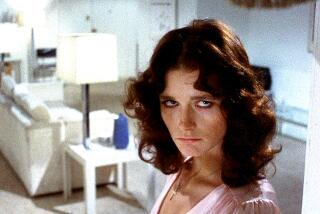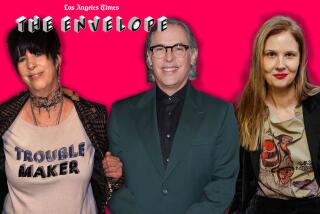Arthur Penn dies at 88; director of landmark film âBonnie and Clydeâ
Arthur Penn, the three-time Oscar-nominated director best known for âBonnie and Clyde,â the landmark 1967 film that stirred critical passions over its graphic violence and became a harbinger of a new era of American filmmaking, died Tuesday. He was 88.
Penn died of congestive heart failure at his New York City home, said his daughter, Molly.
A veteran of directing live television dramas in the 1950s, Penn made his film directorial debut with âThe Left Handed Gun,â a 1958 revisionist western starring Paul Newman as Billy the Kid.
Penn, who was often attracted to characters who were outsiders, directed only a dozen other feature films over the next three decades, including âThe Miracle Worker,â âThe Chase,â âMickey One,â âAliceâs Restaurant,â âLittle Big Man,â âNight Moves,â âThe Missouri Breaksâ and âFour Friends.â
But during his heyday in the late 1960s and early â70s, Penn was in the vanguard of American filmmakers and is considered a pivotal figure in American cinema thanks to âBonnie and Clyde,â the standout film starring Warren Beatty and Faye Dunaway as Depression-era bank robbers-turned folk heroes.
âHad he only directed âBonnie and Clyde,â heâd be a director of note,â film critic Leonard Maltin told The Times in 2009. âBut that was simply the most successful of these highly individual, often idiosyncratic, films that he made in his heyday.â
Because of his relatively small number of films, most of which were made before the 1980s, Penn âhas a somewhat neglected reputation at this point,â said film critic Peter Rainer.
âI think you should judge directors by their best work,â Rainer told The Times in 2009, âand I think âBonnie and Clydeâ is one of the very best American movies and is really sort of the opening salvo for a whole generation of American directors who were breaking boundaries and finding their own way.â
Rainer said actors loved working with the stage-trained Penn.
âI think heâs up there with Sidney Lumet and several others who really understand acting and know how to get the best out of a performer,â he said. âAnd I think he, as opposed to a lot of directors who have theatrical origins, had a real cinematic sense. Thereâs nothing stagy about âBonnie and Clydeâ or âLittle Big Man.ââ
In the late â50s and early â60s, Penn was best known for his work on Broadway as the director of âTwo for the Seesaw,â âThe Miracle Worker,â âAll the Way Home,â âToys in the Attic,â âAn Evening With Mike Nichols and Elaine May,â âGolden Boyâ and âWait Until Dark.â
Among his later Broadway credits are âSly Foxâ and âGolda.â
Pennâs involvement with playwright William Gibsonâs âThe Miracle Workerâ â the story of teacher Anne Sullivanâs efforts to teach the blind and deaf child Helen Keller â began when he directed the drama as a 1957 installment of televisionâs âPlayhouse 90.â
The 1959-61 Broadway production of âThe Miracle Worker,â starring Anne Bancroft and Patty Duke, not only earned Penn a Tony Award as best director but also won a Tony for best play and a Tony for Bancroft as best actress in a play.
Pennâs 1962 film version of âThe Miracle Workerâ earned him his first Oscar nomination as a director, and Bancroft and Duke won Oscars for their performances.
âBonnie and Clydeâ earned Penn his second Oscar nomination.
âI will always treasure the singularly honest, joyful, adventurous intelligence of Arthur Penn both as a collaborator and as a loving friend,â Beatty said Wednesday in a statement.
The filmâs famous ending, in which Bonnie and Clyde are ambushed by lawmen and die in a seemingly endless hail of submachine-gun fire, is considered one of the great moments in movie history.
The graphically violent conclusion, shot with four cameras running at different speeds, was Pennâs primary reason for directing the film.
âI was reluctant to say âyesâ to doing âBonnie and Clydeâ because I wanted an ending that was simply not just violent,â Penn said in an interview for Turner Classic Movies. âI wanted one that would, in a certain sense, transport â lift it â into legend.
âAnd it wasnât until I woke up one morning and I could see that scene with multiple camera speeds and the shape of the almost ballet of dying, and then I knew that that was a film I wanted to make â desperately.â
The release of âBonnie and Clydeâ ignited a critical firestorm.
Outraged by the movieâs âblending of farce with brutal killings,â veteran New York Times film critic Bosley Crowther called it âa cheap piece of bald-faced slapstick comedy that treats the hideous depredations of that sleazy, moronic pair as though they were as full of fun and frolic as the jazz-age cutups in âThoroughly Modern Millie.ââ
But New Yorker film critic Pauline Kael praised âBonnie and Clyde,â calling it âthe most excitingly American American movie since âThe Manchurian Candidate.â The audience is alive to it.â
Newsweek critic Joseph Morgenstern panned the movie as âa squalid shoot-âem-up for the moron tradeâ because it âdoes not know what to make of its own violence.â
But then he watched the film again and famously reversed his position in a second review the next week, saying he considered the first review âgrossly unfair and regrettably inaccurate.â
The Chicago Sun-Timesâ young film critic, Roger Ebert, had no such second thoughts, declaring in his review: â âBonnie and Clydeâ is a milestone in the history of American movies, a work of truth and brillianceâŚ. Years from now it is quite possible that âBonnie and Clydeâ will be seen as the definitive film of the 1960s.â
The movieâs core audience, Penn told the San Francisco Chronicle in 1996, were the same people who were questioning the Vietnam War and viewed the filmâs notorious bank robbers as an extension of their own rebellion.
âThey were acting that movie out months before we had made it,â he said. âThey were in a kind of collective revolt, and the self-recognition that leaped off the screen is really what swept it alongâŚ. It resonated in a way that I never expected.â
As for the violence in the film, he told the Dallas Morning News in 1999 that he âconsidered âBonnie and Clydeâ to be about Vietnam.â
âI was attacked for the violence in the film,â he said, âbut I wanted to show shootings as they really are â bloody and horrifying â so the Vietnam casualty lists wouldnât just be meaningless numbers.â
Nominated for 10 Academy Awards, including best picture, âBonnie and Clydeâ won Oscars for Estelle Parsons for best actress in a supporting role and best cinematography for Burnett Guffey.
Beatty, who also starred in Pennâs 1965 film âMickey One,â praised Penn in a 2000 interview with the New York Times for having âthe soul of an artist.â
âHis intelligence,â Beatty said, âis the factor that resonates most strongly, his intelligence and a lack of interest in pandering.â
Film editor Dede Allen, who edited âBonnie and Clydeâ and five other Penn films, told the Boston Globe in 2008 that he was her âfavorite director.â
âI would cut the phone book for Arthur,â said Allen, who died in April.
Gene Hackman, who received an Oscar nomination for his supporting role in âBonnie and Clydeâ and later starred in Pennâs âNight Movesâ and â Target,â praised Penn as a director.
âHe had his own clear vision, but he was really excited to see what you could bring to a scene, every take,â Hackman said in a statement Wednesday. âYou could feel him over there, just by the camera, pulling for you. However rough and tough his films are, you can always sense his humanity in them.â
Penn was born in Philadelphia on Sept. 27, 1922. His older brother, Irving, later became an internationally renowned photographer. He died in October 2009.
Pennâs parents â his father was a watchmaker, his mother was a nurse â divorced when he was 3, and he and his brother moved to New York with his mother.
Penn later said he moved so often while growing up that he attended at least a dozen schools over eight years. At 14, he and his brother moved back to Philadelphia to live with their father.
While in high school in Philadelphia, Penn acted in school plays and worked for a local radio station, voicing the words of world leaders in dramatizations of events in the news. He was, he later said, âa terrible actor.â
Penn received his first chance to direct at a local amateur playhouse. The idea of becoming a director, he told the Boston Globe in 2008, âjust emerged. I was drawn to the theater as kind of a lonely kidâŚ. I went there, really, for company.â
After joining the Army during World War II, he used his weekend passes while training at Ft. Jackson in South Carolina to frequent a nearby community theater, where he met Fred Coe, who would become an acclaimed producer and director of live TV dramas and would produce Pennâs first two films.
Penn served in the infantry in Europe. After the war ended in 1945, he joined the Soldier Show Company run by director Joshua Logan. He began as the stage manager for a production of the play âGolden Boy.â But after being demobilized, Penn succeeded Logan as head of the company whose casts consisted of professionals and amateurs.
A year later, Penn returned home from Europe and attended Black Mountain College in North Carolina on the GI Bill, followed by two years studying in Italy at the University of Perugia and the University of Florence.
Penn launched his career in television in 1951 as a floor manager for NBCâs âThe Colgate Comedy Hour,â where he worked his way up to assistant director. When the show moved to Hollywood, he went with it.
But when his old friend Coe called him in 1953 with an offer to direct, Penn returned to New York as a director of NBCâs live dramatic anthology âGulf Playhouse: 1st Person.â
Directing assignments on other live dramatic anthology series, such as âGoodyear TV Playhouse,â âPhilco TV Playhouseâ and âPlayhouse 90,â followed.
Penn, a former president of the Actors Studio in New York, married actress Peggy Maurer in 1956. They had two children, Matthew and Molly. His wife and children survive him, as do four grandchildren.
The couple later divided their time between homes in Manhattan and in Stockbridge, Mass., the setting for âAliceâs Restaurant,â his 1969 counterculture Vietnam-era film, inspired by the Arlo Guthrie song of the same name, for which Penn received his third Oscar nomination as a director.
More to Read
Start your day right
Sign up for Essential California for the L.A. Times biggest news, features and recommendations in your inbox six days a week.
You may occasionally receive promotional content from the Los Angeles Times.






